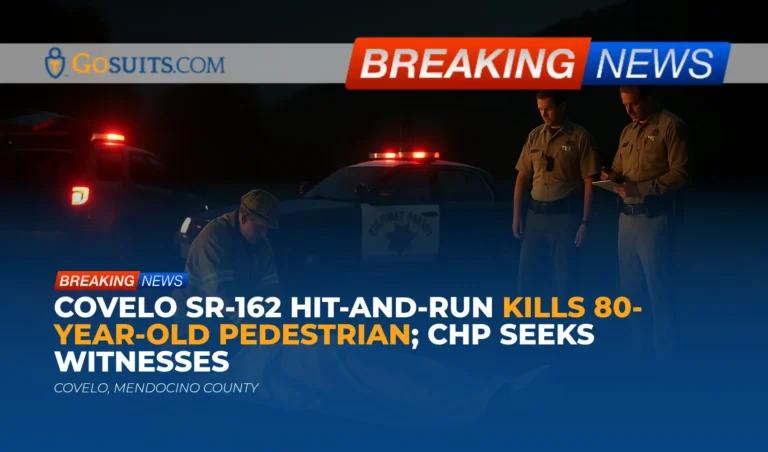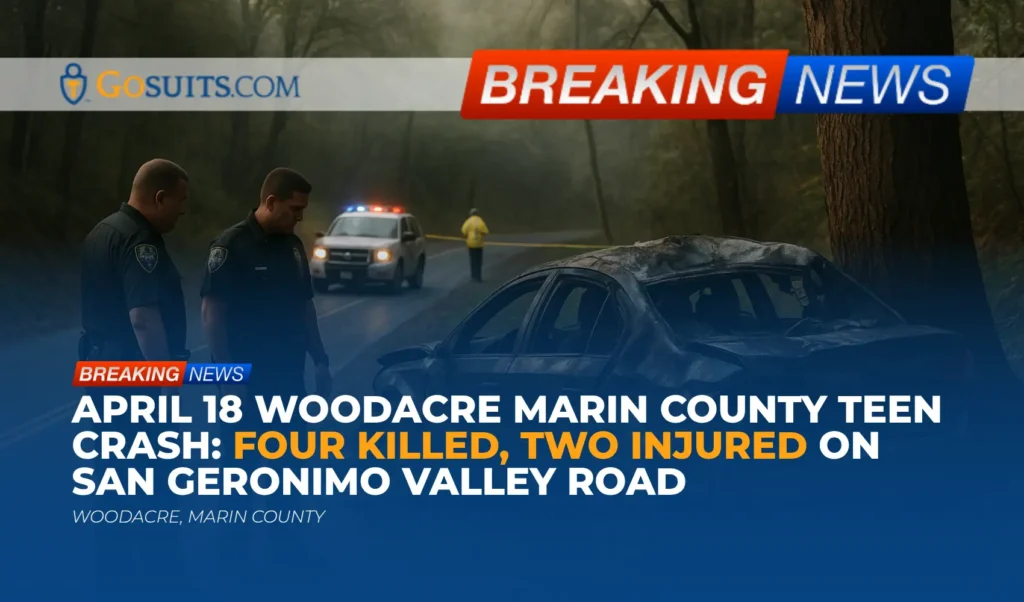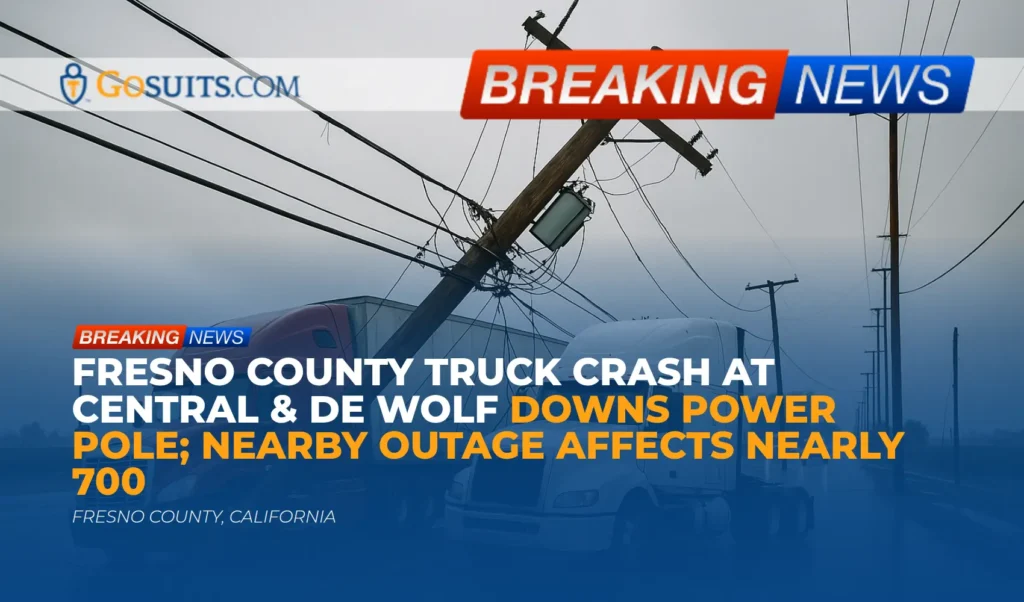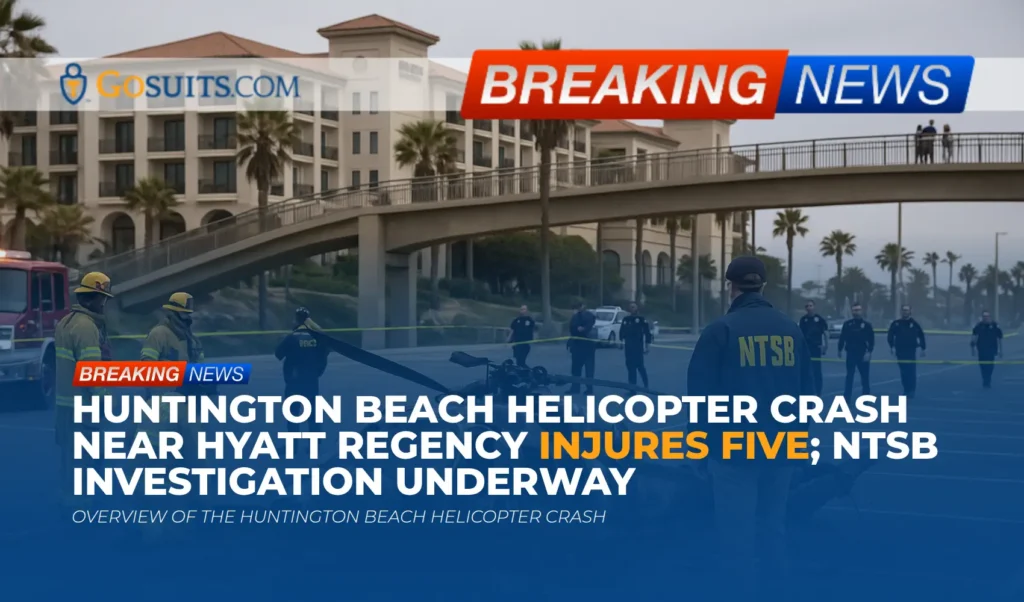- What we know about the Covelo pedestrian collision on Highway 162
- Where and when the incident occurred
- Law enforcement response and coroner’s investigation
- Why leaving the scene matters to a civil wrongful death claim
- Rights of surviving family members in California
- Potential civil liability and insurance pathways after a fatal pedestrian crash
- Evidence to preserve right away
- How to obtain official records and assistance
- Understanding the investigation timeline
- Safety context: pedestrian risks on rural highways
- Deadlines that can affect a civil claim in California
- What to do before speaking with any insurance company
- Time-sensitive next steps and why timing matters
- Commentary from Gosuits Covelo, California Personal Injury Attorney
What we know about the Covelo pedestrian collision on Highway 162
An 80-year-old Covelo resident died after being struck by a vehicle near Covelo in Mendocino County on Sunday evening, according to authorities. The California Highway Patrol reported that the collision occurred around 8 p.m. on State Route 162, north of Poonkinney Road. The driver continued southbound after the impact. A family member of the driver contacted authorities less than an hour later to report the crash. CHP and Mendocino County Sheriff’s deputies interviewed the 20-year-old Covelo woman believed to be the driver that evening. The name of the pedestrian has not been released, pending notification of next of kin.
Volunteer firefighters with the Covelo Volunteer Fire Department provided urgent lifesaving measures, including CPR, but the man was pronounced deceased at 8:26 p.m. The Sheriff-Coroner initiated a coroner’s investigation, with a post-mortem examination planned to determine the official cause and manner of death. The CHP’s Garberville Area office requested that anyone with information call (707) 932-6100.
These facts are preliminary and often evolve as investigators collect witness statements, physical evidence, and forensic data. Families are often left with more questions than answers in the early days. The following sections explain what is typically involved in a fatal pedestrian investigation in California, what records can help clarify what happened, and how civil claims are evaluated when a pedestrian is killed.
Where and when the incident occurred
The collision occurred after dark on State Route 162, north of Poonkinney Road, near Covelo. Rural highways like SR-162 often have limited lighting, higher speed limits, and fewer controlled crossings, which can increase risk to people walking alongside or crossing the roadway. The timing at around 8 p.m. means visibility conditions and headlighting likely played a role in what investigators will analyze.
When investigators assess collisions on rural corridors, they typically consider:
- Lighting and visibility such as darkness, weather, glare, and whether pedestrians or vehicles had lighting or reflectors.
- Speed and stopping distance relative to roadway design and sightlines.
- Driver behavior including attentiveness, impairment screening, lane position, and braking or evasive maneuvers.
- Pedestrian positioning and whether the person was in a travel lane, shoulder, or crossing, as well as clothing visibility and any traffic control devices.
Law enforcement response and coroner’s investigation
Responding deputies and CHP officers arrived within minutes of the radio call. First responders attempted lifesaving care until the Covelo resident was pronounced deceased. A coroner’s investigation was initiated immediately, which is standard whenever a death is unexpected or involves a traffic collision in California. A post-mortem examination helps determine cause and manner of death and may document injuries and timelines that are important in both criminal and civil contexts.
CHP typically leads the traffic investigation and may conduct scene mapping, collect debris and vehicle part numbers, analyze impact locations, and obtain event data recorder (if available). In fatal or complex collisions, CHP may deploy a specialized Multidisciplinary Accident Investigation Team. Although the agency has not released additional details, they will usually compile a collision report that includes factual findings, diagrams, and any cited violations.
Why leaving the scene matters to a civil wrongful death claim
California law requires drivers involved in collisions causing injury or death to stop, provide information, and render aid. Failing to stop can factor into civil liability as evidence of negligence and can be considered when evaluating punitive damages in rare cases depending on the facts. While prosecutors handle criminal charging decisions, civil claims focus on whether the driver’s conduct breached a duty of care and caused harm.
Key legal concepts commonly evaluated in fatal pedestrian claims include:
- Duty of care: Drivers must use reasonable care, keep a proper lookout, and have the vehicle under control.
- Negligence per se: Violation of a safety statute can support liability if the violation caused the harm. For example, duties to stop in injury/death crashes appear in the California Vehicle Code (Cal. Veh. Code § 20001).
- Causation: Whether the driver’s conduct substantially contributed to the death.
- Comparative fault: California uses pure comparative fault, so if multiple factors contributed, fault is apportioned among them.
Civil standards and criminal standards are different. A decision by law enforcement to investigate or not investigate criminally does not by itself resolve civil liability. Families often rely on the full traffic reconstruction, coroner findings, and independent investigation for the civil evaluation.
Rights of surviving family members in California
In California, close family members may bring a wrongful death action to seek civil accountability for a loved one’s death caused by another’s negligence. A separate “survival” claim may be available through the decedent’s estate for certain losses experienced between injury and death. These are distinct claims with different damages and beneficiaries.
While every case is unique, wrongful death damages can include loss of financial support the decedent would have provided, loss of services in the household, and the loss of love, companionship, comfort, care, and guidance. Survival claims can address economic losses the decedent sustained before death, such as medical expenses and, in some situations, property damage. Courts carefully apply these categories to the facts and evidence available.
It is also common for families to pursue insurance claims in parallel. As explained below, multiple insurance policies may be implicated, including the driver’s auto policy, any applicable household policies, and the decedent’s own uninsured/underinsured motorist coverage if they were a pedestrian.
Potential civil liability and insurance pathways after a fatal pedestrian crash
Determining who may be financially responsible often involves multiple layers:
- At-fault driver: The driver’s liability insurance is usually the first source of coverage in a pedestrian fatality, subject to policy limits.
- Vehicle owner: If the driver was operating a vehicle owned by someone else with permission, California’s permissive use laws generally extend the owner’s policy to the incident.
- Uninsured/underinsured motorist (UM/UIM): Pedestrians may be covered by their own auto policy’s UM/UIM benefits if the at-fault driver lacks adequate insurance. UM/UIM can apply even when the injured person was not in a car at the time.
- Medical payments (MedPay): Some auto policies include no-fault MedPay that can help with certain expenses regardless of fault, subject to policy terms.
- Public entities: In rare situations, a dangerous condition of public property may play a role, such as inadequate sight distance or missing signage. Claims against public entities have special notice requirements and shorter deadlines, discussed below.
Insurance adjusters evaluate liability, causation, and damages and often request recorded statements early. Because statements can be used to minimize or dispute claims, it is wise to consult with a qualified attorney before engaging with any insurance representative.
Evidence to preserve right away
Evidence can fade quickly after a rural highway collision. Early steps that are often helpful include:
- Identify and speak with witnesses and note contact information. Ask if anyone captured dashcam footage or photos.
- Photograph the scene at similar lighting conditions, including roadway markings, sightlines, lighting, and any nearby driveways or intersections.
- Preserve the decedent’s clothing and personal items as they may assist visibility and impact analyses.
- Request nearby surveillance from homes or businesses along SR-162; many systems overwrite within days.
- Document communications with insurers and law enforcement by saving emails, letters, and call logs.
Families should consider coordinating these efforts through an attorney so that preservation letters can be sent promptly to involved parties and potential custodians of video or data.
How to obtain official records and assistance
Official records help clarify what happened and support any civil insurance claim. The resources below are generally available in California.
CHP collision report and related records
CHP prepares a Traffic Collision Report for injury and fatal incidents. Eligible parties can request a copy using the CHP 190 form. The form explains how to identify the correct Area office and what information to include. See the CHP’s official collision report request resource at CHP 190: Traffic Collision Report Request.
If the Garberville Area office is handling the investigation, its contact page can be found through the CHP’s office directory at CHP Garberville Area Office. Families may ask about report availability, supplemental reports, and whether specialized teams were involved.
Coroner records and death certificate
The Sheriff-Coroner’s office conducts the post-mortem examination and may release an autopsy report to next of kin, subject to local policy and state law. While autopsy reports are not issued by a statewide agency, certified death certificates are issued through the California Department of Public Health. Instructions for obtaining certified copies are available at California Department of Public Health: Vital Records.
Families can contact the county Sheriff-Coroner for timelines on autopsy completion, next-of-kin authorization, and release of personal effects. The contact information is available on the county’s official website or by calling the Sheriff’s non-emergency line.

911 audio, CAD logs, and radio traffic
Dispatch audio and computer-aided dispatch (CAD) logs can help establish response times and initial observations. These materials can sometimes be requested under the California Public Records Act. The Attorney General’s office provides an overview of public records rights here: Office of the Attorney General: Open Government. Some records may be withheld or redacted based on exemptions, especially in active investigations.
Victim compensation support
California’s Victim Compensation Board offers support for certain crime-related expenses, including funeral and burial costs, subject to eligibility and documentation. Information is available at California Victim Compensation Board. Eligibility does not determine civil liability and can be considered alongside any insurance claims.
Traffic safety and pedestrian data sources
Reliable statistics can provide context for risk and prevention. Useful sources include:
- National Highway Traffic Safety Administration: Pedestrian Safety
- California Office of Traffic Safety: Research and Statistics
Understanding the investigation timeline
Fatal crash investigations unfold over weeks to months. Initial reports and scene diagrams may be completed within days, but supplemental reports, toxicology results, and coroner findings often take longer. Autopsy reports can take several weeks depending on laboratory backlogs and whether specialized testing is required.
It is common for the collision report to be released in stages. Families may first receive an initial report without attachments and later obtain supplements with more detail. If a mechanical inspection was conducted or data was recovered from a vehicle’s event data recorder, those items may arrive later as separate reports. Staying in periodic contact with CHP and the Sheriff-Coroner’s office can help set expectations without interfering with the ongoing investigation.
Safety context: pedestrian risks on rural highways
Walking along or crossing rural highways carries specific risks: higher speed limits increase injury severity, and the absence of street lighting reduces the time drivers have to detect pedestrians. Nationally, pedestrian fatalities have remained a serious concern in recent years. NHTSA’s research shows thousands of pedestrian deaths annually, with a disproportionate share occurring after dark and on roadways without intersections. See NHTSA’s pedestrian safety resources at NHTSA Pedestrian Safety.
California data reflect similar patterns. The California Office of Traffic Safety publishes annual reports and dashboards showing trends in pedestrian injuries and fatalities, including time-of-day distributions and roadway types. See OTS research and statistics at OTS Research. These data help engineers and agencies target improvements like lighting, shoulder widening, and speed management.
Deadlines that can affect a civil claim in California
Time limits apply to civil actions in California. While this article is for general information only, the following statutes are commonly relevant:
- General wrongful death limitations period: Two years from the date of death in most cases. See Code of Civil Procedure § 335.1.
- Claims involving public entities: Written government claims typically must be presented within six months for personal injury or wrongful death before a lawsuit may be filed. See Government Code § 911.2.
There are exceptions and special rules, so understanding the correct deadline for a particular situation is important. Waiting can jeopardize rights if critical evidence is lost or a statutory cutoff passes.
What to do before speaking with any insurance company
Insurance representatives often reach out quickly after a fatal collision. What is said in those early conversations can be recorded and later used to dispute liability, challenge damages, or attribute fault. Before providing any recorded statement, signing medical releases, or accepting any payment, it is prudent to consult with a seasoned personal injury attorney.
General cautions include:
- Do not agree to a recorded statement until you have obtained legal guidance about your rights and responsibilities.
- Limit authorizations to what is strictly necessary; broad medical releases can result in fishing expeditions through unrelated records.
- Keep written records of all contacts with insurers, including dates, names, and summaries of conversations.
An attorney can interface with multiple insurers, coordinate benefits, and help ensure no coverage avenue is overlooked, including UM/UIM and MedPay where available.
Time-sensitive next steps and why timing matters
After a fatal pedestrian collision on a rural highway, several immediate actions can help protect civil claims and preserve clarity about what happened. Acting promptly can make a meaningful difference because physical evidence deteriorates, memories fade, and statutory deadlines approach quickly.
- Secure official records: Request the CHP collision report using the official CHP 190 form and ask to be notified when supplements are available. Contact the Sheriff-Coroner for autopsy status and procedures for release of reports to next of kin. Obtain certified death certificates through CDPH Vital Records for insurance and estate needs.
- Preserve third-party video: Send written preservation requests to nearby residences and businesses asking them to save any exterior or driveway camera footage from the time window. Many systems overwrite within days.
- Document the roadway environment: Capture photos and video at a similar time of night to reflect lighting, traffic, and visibility conditions along SR-162 near Poonkinney Road.
- Centralize information: Keep a secure file of medical, coroner, funeral, and memorial expenses, as well as communications with insurers and agencies. Organized records support later claims.
- Be mindful of deadlines: Note the two-year general period for wrongful death actions (CCP § 335.1) and the six-month government claim requirement when a public entity might be implicated (Gov. Code § 911.2).
- Consult before contacting insurance: Speak with an attorney first. Statements provided to any insurer can be used later to limit or deny claims.
Taking these steps promptly can help preserve the most accurate record of events and prevent avoidable claim obstacles later.

Commentary from Gosuits Covelo, California Personal Injury Attorney
Our hearts go out to the Covelo community and to the loved ones of the 80-year-old resident who lost his life on State Route 162. Articles like this are intended for educational purposes and general information. They cannot reflect every nuance of a specific case, but they aim to offer clarity during an extraordinarily difficult time.
From a civil perspective, a nighttime pedestrian fatality on a rural highway raises urgent questions about visibility, speed, lookout, lane position, and the driver’s decision to leave the scene. When a driver fails to stop after a collision that causes injury or death, that choice can become a significant factor in civil evaluations of responsibility. Thorough traffic reconstruction, scene documentation at night, witness statements, and coroner findings are all critical to getting an accurate picture of what happened and why.
Insurance companies and corporations are sophisticated repeat players. They know how to move quickly to minimize their financial exposure. Early recorded statements can be framed in ways that later undermine a family’s claim. Adjusters may request broad medical or personal records, or present early settlement offers before key facts or the full impact of the loss is understood. It is not uncommon for critical coverage, like UM/UIM benefits available to pedestrians through their own auto policies, to be overlooked unless someone is actively looking for it and coordinating overlapping policies.
Even in the face of grief, timing matters. A free consultation with a skilled personal injury attorney can provide an informed overview of the process, identify sources of coverage, and outline the steps needed to preserve evidence and meet deadlines. It is an opportunity to ask questions and understand options without pressure or obligation. In a case like this near Covelo, thoughtful early action can help ensure that the civil process honors the truth of what happened and protects the rights afforded under California law.
References
- California Highway Patrol: Traffic Collision Report Request (CHP 190)
- CHP Garberville Area Office
- California Vehicle Code § 20001
- California Code of Civil Procedure § 335.1
- California Government Code § 911.2
- California Department of Public Health: Vital Records (Death Certificates)
- California Victim Compensation Board
- California Office of the Attorney General: Open Government/Public Records
- NHTSA: Pedestrian Safety
- California Office of Traffic Safety: Research and Statistics






